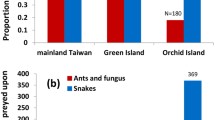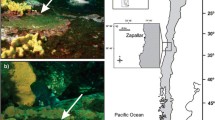Abstract
Life history theory predicts that parents will not raise unrelated offspring. For seabirds, an ability to recognize their own eggs and chicks can prevent a costly mistake. We tested whether Magellanic Penguins (Spheniscus magellanicus) would discriminate against artificial eggs by presenting nine types of egg-objects and one type of artificial chick to penguins at their nests. Magellanic Penguins regardless of their sex or breeding status accepted all egg-objects. A generalized linear mixed model showed that mass and number of dimensions were the most important factors in predicting whether the object was accepted: flat egg-objects and light egg-objects were less likely to be incubated than round, normally weighted ones. We also tested whether Magellanic Penguins would retrieve egg-objects more frequently if the object was within 1 m of the nest cup. Penguins retrieved 75 % of objects that were 1 m from the nest cup, but only 25 % of objects that were 2 m from the nest cup. Lastly, we tested whether penguins would accept artificial chicks. We found that pairs with chicks less than 3 weeks of age (i.e., not out of the guard stage) were at least twice as likely to brood an artificial chick than pairs with chicks older than 3 weeks, pairs that had lost their chicks, or unmated males.
Zusammenfassung
Akzeptanz von Ei-Attrappen und künstlichen Küken bei Magellanpinguinen ( Spheniscus magellanicus )
Die Life-History-Theorie geht von der Annahme aus, dass Eltern keine nicht mit ihnen verwandten Jungen aufziehen. Die Fähigkeit, die eigenen Eier und Küken zu erkennen, kann bei Seevögeln kostspieligen Irrtümern vorbeugen. Wir untersuchten, ob Magellan pinguine (Spheniscus magellanicus) Ei-Attrappen als solche erkennen und unterscheiden können und boten dazu den Pinguinen am Nest neun verschiedene Arten eiförmiger Objekte sowie ein künstliches Küken an. Unabhängig von Geschlecht oder Brutstatus akzeptierten die Magellanpinguine alle eiförmigen Objekte. Ein generalisiertes lineares gemischtes Modell zeigte, dass die Masse sowie die Anzahl der Dimensionen die Hauptfaktoren dafür darstellten, ob das Objekt angenommen wurde: Flache oder leichte Ei-Attrappen wurden mit geringerer Wahrscheinlichkeit bebrütet als runde, normalgewichtige. Wir untersuchten ebenfalls, ob Magellanpinguine die Ei-Attrappen häufiger ins Nest zurückrollten, wenn sich das Objekt im Umkreis von einem Meter zur Nestmulde befand. Die Pinguine holten 75 % der Objekte, die sich im Abstand von einem Meter befanden, in die Nestmulde zurück, dagegen nur 25 % der Objekte, die zwei Meter vom Nest entfernt lagen. Abschließend untersuchten wir noch, ob die Pinguine künstliche Küken annehmen. Es stellte sich heraus, dass Paare mit Küken, die jünger waren als drei Wochen (d. h. während der Bewachungsphase) mit mindestens doppelt so hoher Wahrscheinlichkeit ein künstliches Küken bebrüteten als Paare mit Küken, welche älter als drei Wochen waren, Paare, die ihre Küken verloren hatten, oder unverpaarte Männchen.




Similar content being viewed by others
References
Angelier F, Barbraud C, Lormeé H, Prud’homme F, Chastel O (2009) Kidnapping of chicks in emperor penguins: a hormonal by-product? J Exp Biol 209:1413–1420
Auben T, Jouventin P (2002) How to vocally identify kin in a crowd: the penguin model. Adv Stud Behav 31:243–263
Beecher MD, Stoddard PK, Loesche P (1985) Recognition of parents’ voices by young cliff swallows. Auk 102:600–605
Beer CG (1979) Vocal communication between laughing gull parents and chicks. Behaviour 70:118–146
Birkhead TR (1978) Behavioral adaptation to high nesting density in the common guillemot (Uria aalge). Anim Behav 26:321–331
Boersma PD, Rebstock GA (2009) Intraclutch egg-size dimorphism in Magellanic penguins (Spheniscus magellanicus): adaptation, constraint, or noise? Auk 126:335–340
Boersma PD, Stokes DL, Yorio PM (1990) Reproductive variability and historical change of Magellanic penguins (Spheniscus magellanicus) at Punta Tombo, Argentina. In: Davis LS, Darby JT (eds) Penguin biology. Academic, San Diego, pp 15–43
Brown KM (1998) Proximate and ultimate causes of adoption in ring-billed gulls. Anim Behav 56:1529–1543
Buckley PA, Buckley FG (1972) Individual egg and chick recognition by adult royal terns (Sterna maxima). Anim Behav 20:457–462
Buntin JD (1996) Neural and hormonal control of parental behaviour in birds. Adv Stud Behav 25:161–213
Clark JA, Boersma PD, Olmsted DM (2006) Name that tune: call discrimination and individual recognition in Magellanic penguins. Anim Behav 72:1141–1148
Conover MR (1985) Foreign objects in bird nests. Auk 102:696–700
Davies SJ, Carrick R (1962) On the ability of crested terns, Sterna breggi, to recognize their own chick. Aust J Zoo 10:171–177
Davis LS, McCaffrey FT (1989) Recognition and parental investment in Adélie penguins. Emu 89:155–158
Fredrickson LH, Weller MW (1972) Responses of Adélie penguins to colored eggs. Wilson Bull 84:309–314
Friesen VL, Montevecchi WA, Barrett RT, Davidson WS (1996) Molecular evidence for kin groups in the absence of large-scale genetic differentiation in a migratory bird. Evolution 50:924–930
Gaston AJ, DeForest LN, Noble DG (1993) Egg recognition and egg stealing in murres (Uria spp.). Anim Behav 45:301–306
Gaston AJ, Eberl C, Hipfner M, Lefevre K (1995) Adoption of chicks among thick-billed murres. Auk 112:508–510
Goldsmith AR (1991) Prolactin and avian reproductive strategies. Proc Int Ornithol Congr Ornithol 20(4):2063–2071
Hood LC, Boersma PD, Wingfield JC (1998) The adrenocortical response to stress in incubating Magellanic penguins (Spheniscus magellanicus). Auk 115:76–84
Jouventin P, Barbraud C, Rubin M (1995) Adoption in emperor penguins Aptendodytes forsteri. Anim Behav 50:1023–1029
Lyon BE, Eadie JM (2008) Conspecific brood parasitism in birds: a life-history perspective. Annu Rev Ecol Evol Syst 39:343–363
Massaro M, Setiawan AN, Davis LS (2007) Effects of artificial eggs on prolactin secretion, steroid levels, brood patch development, incubation onset and clutch size in the yellow-eyed penguin (Megadyptes antipodes). Gen Comp Endocrinol 15:220–229
Nimon AJ, Schroter RC, Oxenham RKC (1996) Artificial eggs: measuring heart rate and effects of disturbance in nesting penguins. Phys Behav 60:1019–1022
Oosthuizen WC, Nico de Bruyn PJ (2009) King penguin brooding and defending a sub-Antarctic skua chick. Polar Biol 32:302–305
Poulsen H (1953) A study of incubation responses and some other behavior patterns in birds. Vidensk Medd Dan Naturhist Foren 115:1–131
Prevett JP, Prevett NS (1973) Egg retrieval by blue geese. Auk 90:202–204
Rafferty NE, Boersma PD, Rebstock GA (2005) Intraclutch egg-size variation in Magellanic penguins. Condor 107:923–928
Rebstock GA, Boersma PD (2011) Parental behavior controls incubation period and asynchrony of hatching Magellanic penguins. Condor 113:316–325
Reid WR, Boersma PD (1990) Parental quality and selection on egg size in the Magellanic penguin. Evolution 44:1780–1786
Renison D, Boersma PD, Martella M (2002) Winning and losing: causes for variability in outcome of fights in male Magellanic penguins (Spheniscus magellanicus). Behav Ecol 13:462–466
Richardson F (1967) Black tern nest and egg moving experiments. Murrelet 48:52–56
Riska DE (1984) Experiments in nestling recognition in brown noddies (Anous stolidus). Auk 101:605–609
Rothstein SI (1990) A model system for coevolution: avian brood parasitism. Annu Rev Ecol Syst 21:481–508
Sears HF (1978) Nesting behavior of the gull-billed tern. Bird-Banding 49:1–16
Setiawan AN, Davis LS, Darby JT, Loman PM, Young G, Blackberry MA, Cannell BL, Martin GB (2007) Effects of artificial social stimuli on reproductive schedule and hormone levels of yellow-eyed penguins (Megadyptes antipodes). Horm Behav 51:46–53
Shugart GW (1987) Individual clutch recognition by Caspian terns (Sterna caspia). Anim Behav 35:1563–1565
Stearns SC (1976) Life-history tactics: a review of the ideas. Q Rev Biol 51:3–47
Stoddard PK, Beecher MD (1983) Parental recognition of offspring in the cliff swallow. Auk 100:795–799
Stokes DL, Boersma PD (1991) Effects of substrate on the distribution of Magellanic penguins (Spheniscus magellanicus). Auk 108:923–933
Stokes DL, Boersma PD (1998) Nest-site characteristics and reproductive success in Magellanic penguins (Spheniscus magellanicus). Auk 115:24–49
Stokes DL, Boersma PD (2000) Nesting density and reproductive success in a colonial seabird, the Magellanic penguin. Ecology 81:2878–2891
Taylor RH (1962) The Adélie penguin Pygoscelis adeliae at Cape Royds. Ibis 104:176–204
Tenaza R (1971) Behavior and nesting success relative to nest location in Adélie penguins. Condor 73:81–92
Tinbergen N (1951) The study of instinct. Oxford University Press, Oxford
Tinbergen N (1958) Curious naturalists. The University of Massachusetts Press, Amherst
Tinbergen N (1960) The Herring Gull’s world. Harper, New York
Trivers RL (1972) Parental investment and sexual selection. In: Campbell B (ed) Sexual selection and the descent of man. Aldine, Chicago, pp 136–179
Vleck CM, Bucher TL, Reed WL, Kristmonsdottir AY (1999) Changes in reproductive hormones and body mass through the reproductive cycle in the Adelie penguin (Pygoscelis adeliae), with associated data on courting-only individuals. In: Adams N, Slowtow R (eds) Proc Int Ornithol Cong 22:1210–1223
Volkman NJ, Trivelpiece W (1981) Nest-site selection among Adelie, chinstrap, and Gentoo penguins in mixed species rookeries. Wilson Bull 93:243–248
Yorio P, Boersma PD (1992) Consequences of nest desertion and inattendance for Magellanic penguin hatching success. Auk 111:215–218
Acknowledgments
This study was funded by The Penguin Project, sponsored by the Wildlife Conservation Society (WCS) and the University of Washington, Exxon-Mobil Foundation, Disney Wildlife Conservation Fund, National Geographic Society, the Chase, Cunningham, MKCG, Offield, Peach, Thorne, and Kellogg foundations, the Wadsworth Endowed Chair in Conservation Science, and Friends of the Penguins. The research was carried out under a joint agreement between WCS and the Office of Tourism, Province of Chubut, Argentina. We thank the Province of Chubut and the La Regina family for access to the penguin colony. Thanks to Jennifer Ruesink, Brian Walker, and two anonymous reviewers for very helpful comments that improved the manuscript.
Author information
Authors and Affiliations
Corresponding author
Additional information
Communicated by P. H. Becker.
Rights and permissions
About this article
Cite this article
Wagner, E.L., Lee, E.J. & Boersma, P.D. Patterns of acceptance of artificial eggs and chicks by Magellanic Penguins (Spheniscus magellanicus). J Ornithol 154, 99–105 (2013). https://doi.org/10.1007/s10336-012-0875-6
Received:
Revised:
Accepted:
Published:
Issue Date:
DOI: https://doi.org/10.1007/s10336-012-0875-6




